September/October 2019
Life is Better in The Bush
Plenty of game and a whole lot more from Pilanesberg to Mapungubwe to The Kruger
In June we decided we weren’t going further north in Africa than southern Tanzania. At that time we made a 180-degree turn and began slowly and gently moving back down towards Durban, South Africa, where we first hit African shores back in July of 2018. We are now getting a bit closer to completing that large and lumpy circle.
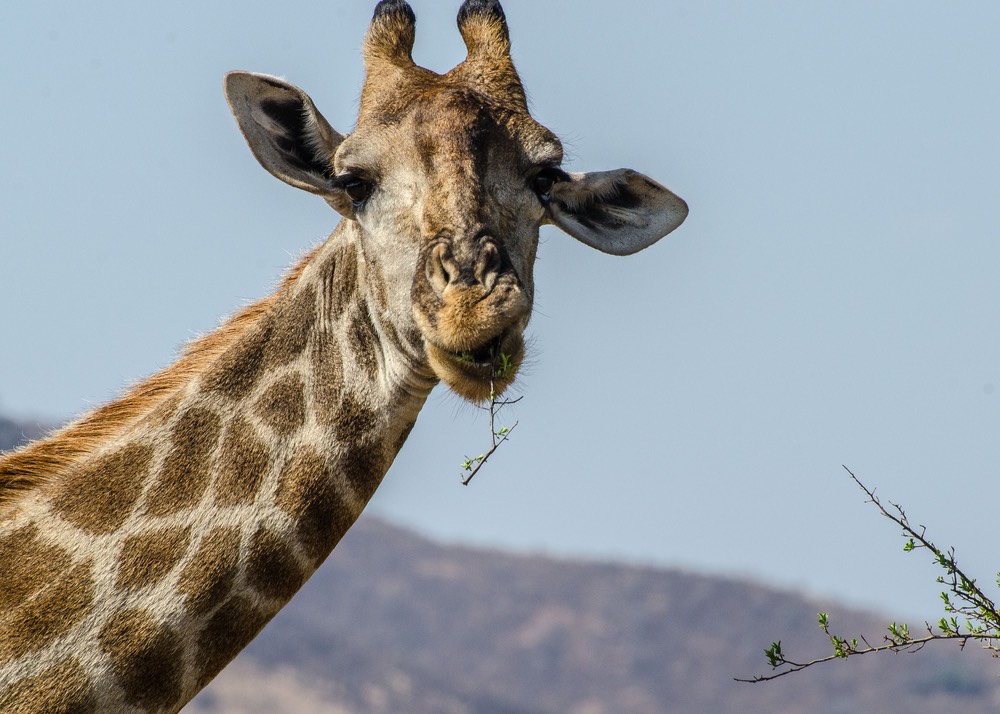
In mid-September we crossed back into South Africa with a plan stay in the eastern part of SA until we ship back to the United States — once again from Durban — at the end of November. There’s still a lot of unexplored territory here that we’ve been wanting to enjoy, as well as friends to visit and favorite spots to see one last time. We think we’ve made a pretty good start on all fronts and hope you’ll agree.
When we crossed the border at Martin’s Drift, we saw that nothing was working any better now than it had when we’d last seen it in May — not surprise at all. All the traffic, in both directions, has to take its turn crossing a narrow old bridge with no working directional signals and we felt very, very small among the huge trucks continually edging us toward the low barrier that separated us from the mighty Limpopo River not-that-far below us. But we survived, and happy to have completed our final border experience in Africa, turned south in hopes of seeing some of the prosperous and productive farmland in Limpopo Province. It was a bit surprising to be among rivers and green mountains, as we’d spent so much time in very dry, barren areas not that far away. We’ve seen this frequently in Africa, if there’s a river nearby that has water in it, things seem to flourish and irrigated fields look very productive. We spent the night on the edge of the Mokolo River, at a campsite attached to a lodge with kudu roaming around enjoying the grass. A very nice welcome to the large Waterberg Biosphere Reserve.
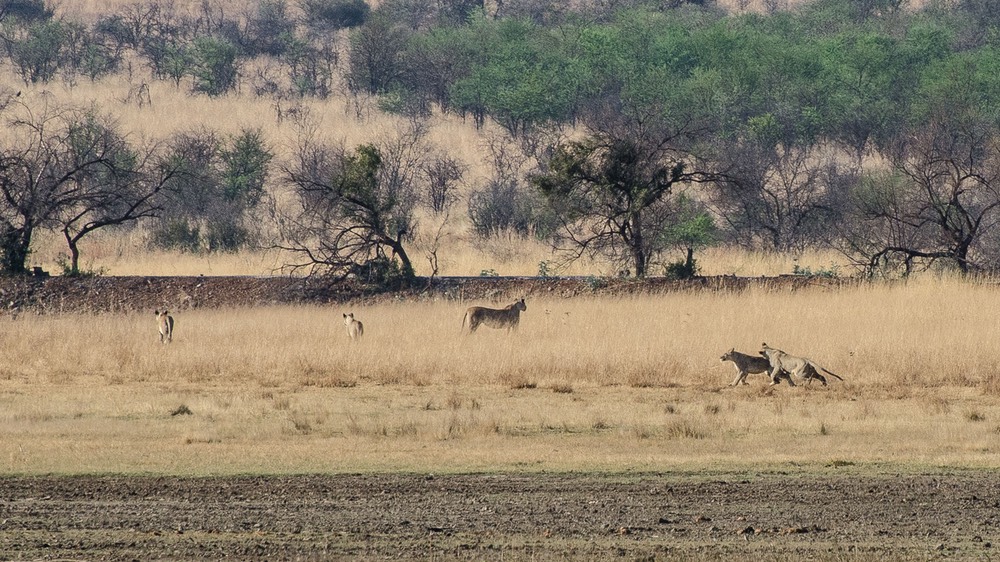
We wandered a bit here, staying in a couple of places, before heading over to visit an old friend, Pilanesberg National Park. We’d had a very good time here before, and this time was even better. There were tons of animals to enjoy, including a group of lions driving the local wildebeests off their turf. There were six of them, looking to us like two lionesses teaching their youngsters how all this was done. We just sat and enjoyed the action. Just before that we’d spotted a cheetah with a couple of cubs in the high grasses nearby. We couldn’t see them well, but they were certainly recognizable. All that within the first 30 minutes of starting our early morning drive. We hit the road just as the sun was coming up, and it gave a soft, orangish light to everything we saw. Delightful, and a great start to our time back in South Africa.
During our day’s drive we continued to see plenty of game, including… well we won’t list them all, but many types of antelope, a couple of rhino, some great giraffe sightings, and really playful elephant at the same waterhole we featured in our very first message from Africa, And Then…, last year. Elephant are really fun to watch when they get to a waterhole. They love to wallow and play in the mud and water; they’re really cute, just like kids.
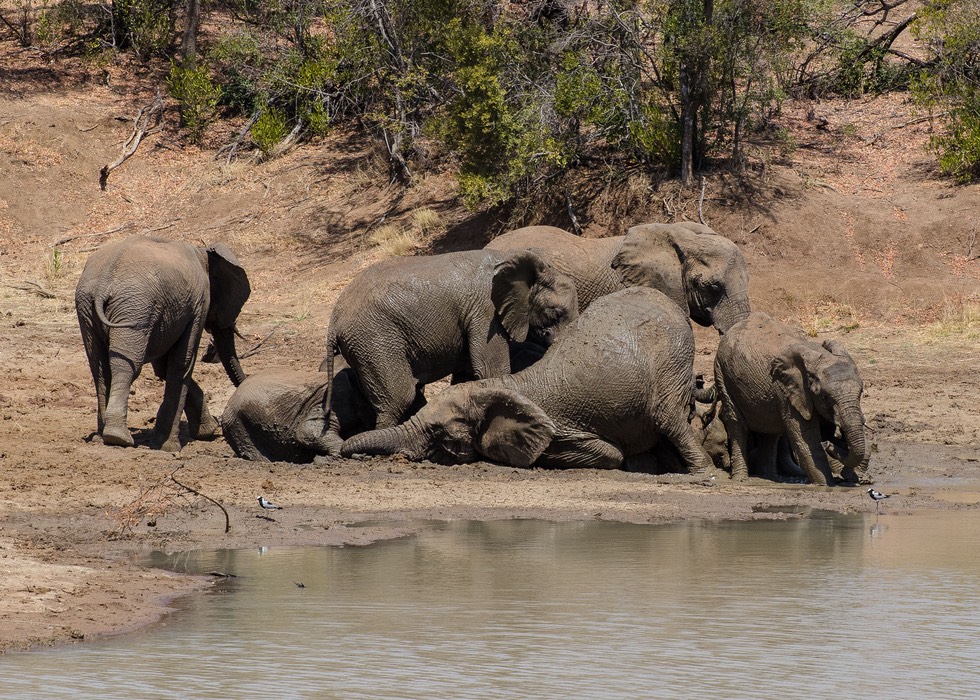
We had entered SA where we did in part so we could aim for Pilanesberg, but also so we could spend some time with our friends in Pretoria. We knew there had been some unrest in the city, but they live on the edges, and said we shouldn’t have any problems; and we didn’t. We had a good visit, and made possible plans for a last get-together at the end of October. Jakes and Ina have become close friends, and we will miss them, along with all the other good friends we’ve made in Africa. Throughout the countries we’ve visited here, the people have been wonderful and helpful and just terrific. Wish we could take them all with us when we leave!
But onward. We had made bookings for two national parks, starting about 10 days out, the first being Mapungubwe NP right up on the border with both Botswana and Zimbabwe, and then further east, to Kruger NP, aka ‘The Kruger’. So we started working our way north towards them. From Pretoria, we drove northeast through Polokwane, and then took a smaller road east towards Tzaneen, into the mountains and mists and much cooler temperatures up at about 1500 meters. This area has a different climate than anything west of here as it gets its rain — and quite a lot of it — from the east rather than the west. Incoming clouds from the Indian Ocean come up against these mountains and drop their moisture. It was lovely to be cool even if only for a few days.
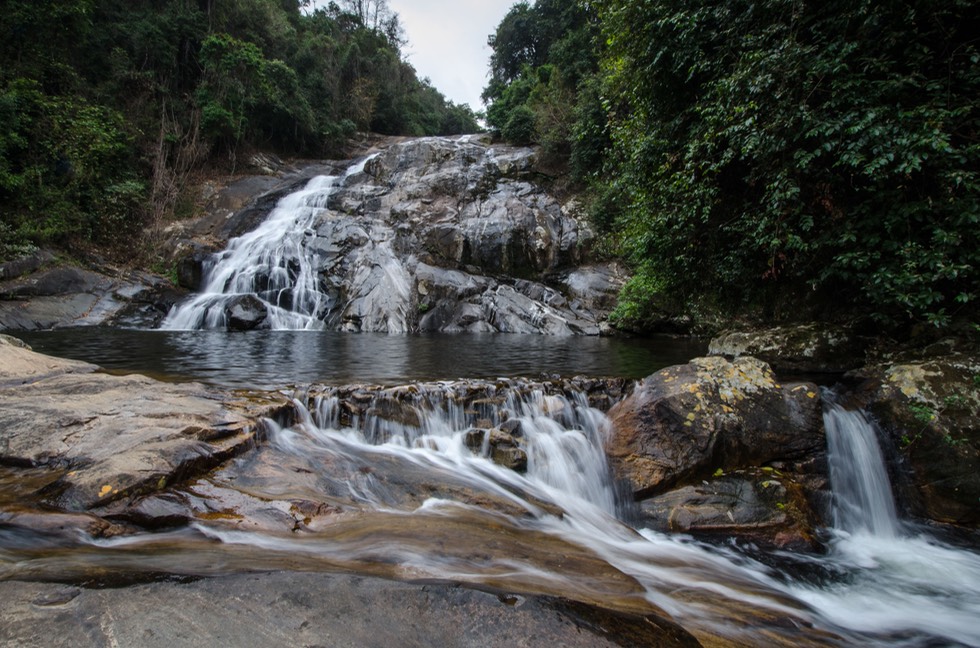
The Tzaneen area has two lovely road passes you can go over, the Magoebaskloof and the Modjdjiskloof; they are very close together, impossible to spell (much less pronounce), and not well differentiated on the maps; but we definitely drove over them both. Makes you nuts, but altogether we had a very good time. This is a beautiful area to visit. We made a nice stop at Debengeni Falls, a pretty little place for a picnic; it still had enough water coming over the rocks to be quite lovely, and the forested area was a good place to explore. It is a great spot for families with plenty of picnic tables and braai stands (barbeques) available.
We wild camped for the night west of Tzaneen, near Ebenezer Dam, on the edge of a woodlot with nice trees and views of the water. It was cool, foggy, and a welcome relief from the increasingly hot weather we’d been experiencing near the Pretoria area. Driving down through the fog to get to town the next morning, the thing that really made us realize we were losing altitude was passing a sign saying Crocodile Daily Feeding — rather startled us!
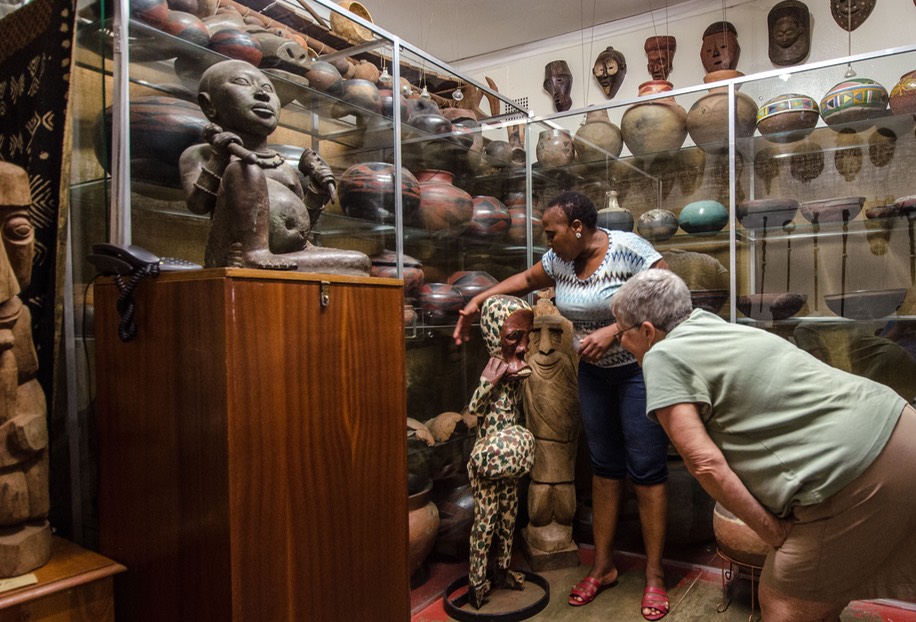
Tzaneen, although lower in altitude, was still in fog, and driving in we were enjoying rhododendrons, jacarandas and palms — what a pretty town. We had been told that there is a nice small museum here, so we went to check it out. It is filled with a large collection of donated African artifacts, mostly wood carvings. They were all in good shape, and came from a very large part of sub-saharan Africa. There was a local lady there who gave us a guided tour, and she was excellent, really enthusiastic. Much of what she does at the museum is teach the old stories and legends to school groups and it showed. She really put us in the middle of the legends associated with various objects, and made us feel part of history. It was a great experience; this museum is a real treat.
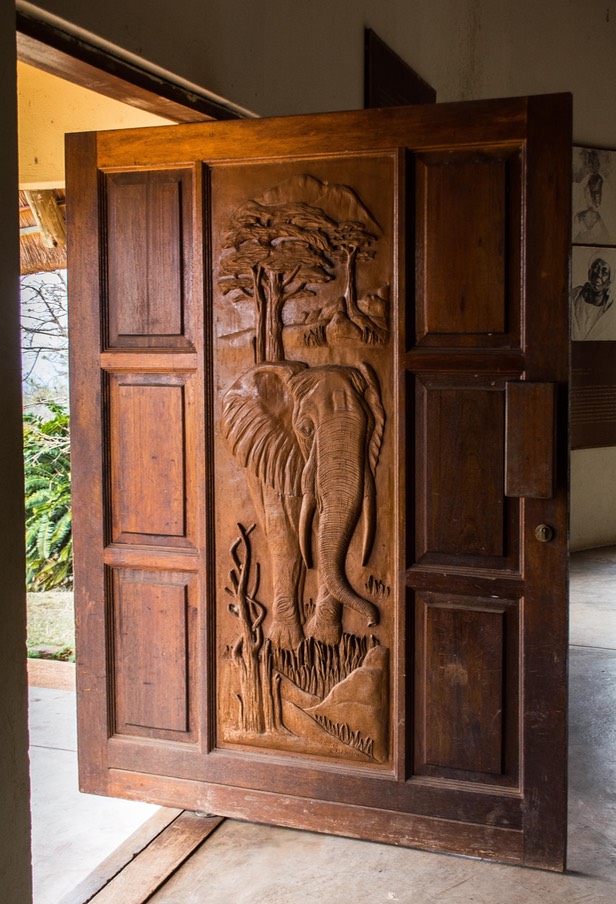
From Tzaneen we went on north to the Modjadji Nature Reserve. The reserve is home to a large botanic garden filled with cycad trees, a very ancient plant we usually associate with dinosaurs. They are totally cool (Kathy speaking here, Rick’s take is a wee bit less enthusiastic). We had run into a close relative in Australia (yes, of the cycads). But these were really different, and quite amazing (yawn). I romped among them, enjoying their luxurious growth and strangely bent limbs. It was great. There was a small building with good information on the walls, along with some interesting photographs and drawings; but the best thing was the entry door, which was hand carved from beautiful wood and wonderfully done. Quite splendid (can we go now).
This was a great route to take heading north; we traveled through the Letaba Valley and then further north up to Louis Trichardt, a surprisingly nice town. This entire area is more “African” than much of South Africa — people walking along the roadsides in colorful clothing, produce for sale along the road, and very big celebrations of Heritage Day, with many people in more traditional clothes than usual in SA. We found a nice little spot to stay in a forest reserve near town, up in the hills — back into the mists at about 1300 meters. It was cool and charming, with lush old trees and lots of birds to enjoy. A nice surprise was a knock on our door — a fellow traveler we’d met in Botswana. We had a nice chat and then John moved on to the next spot in his rounds. We really recommend this area; there are hiking trails, a pub bar on site, generally cool temperatures and hot showers!
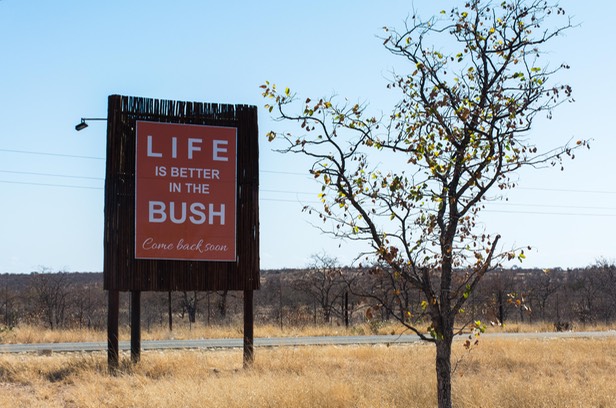
On our way out of town we stopped at a couple of places looking for help about our cranky water pump (in the house, not the engine); no solutions, but lots of commiserating. We’ll keep on truckin’, and check on it as we can.
By now we were getting closer to Mapungubwe. We quickly passed through the city of Messina (aka Musina these days). This is a rather chaotic spot, as it’s quite close to the main SA/Zimbabwe border crossing and full of the usual trucks and dusty mess and all the rest. But we weren’t crossing into Zimbabwe. We were turning west and following the border (which shadows the Limpopo River) until we reached the entrance to the national park. We wanted to enter the park early in the morning, and so we wanted to stay the night before as near as we could manage. We found this wonderful bush camp not far from the entrance, had a nice night, then got a decent start the next day heading to the park. There we found the title for this message on a wonderful sign as you leave this bush camp: “Life is better in the bush.” We agree completely.
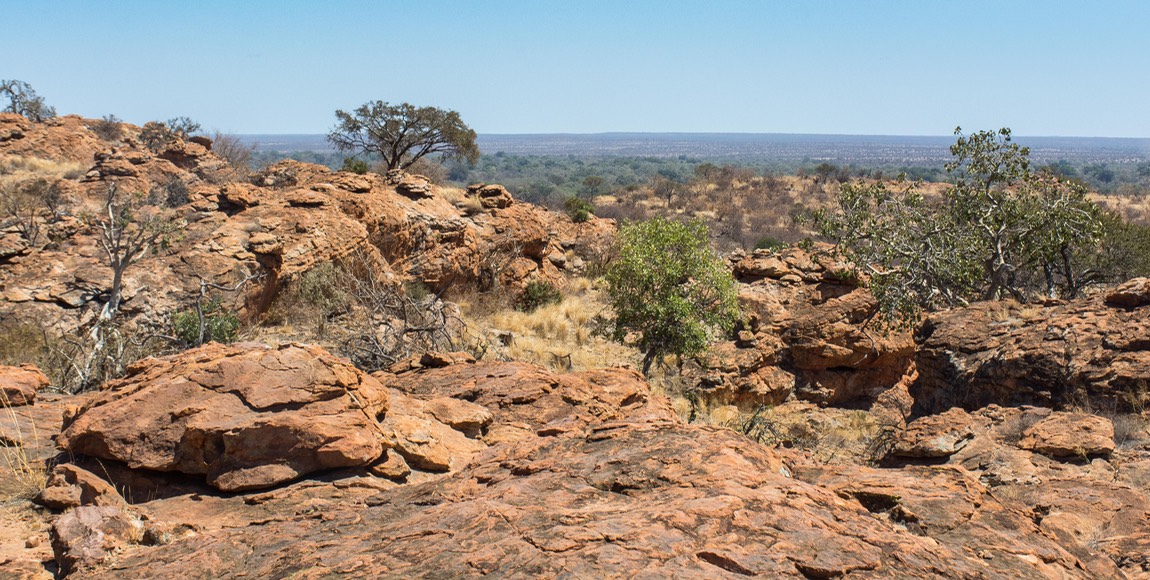
Mapungubwe NP was pretty neat. It’s a bit strangely laid out, being in two distinct sections; you have to exit one and travel on down the highway to get to the other. Also, it’s way to hell and gone off the beaten track, but that’s a huge part of the pleasure. The remote location keeps it underutilized, but quite enjoyable, and you certainly get close to the animals. In the early evening I was sitting outside finishing my book; two warthogs trotted purposefully by; I finished the last page, got up, and went inside to fix dinner; just life as usual. The path the elephants take at night brings them right to the edge of the campsite, so we could hear them passing by, which was very nifty. We also heard wild dogs in the night. A great place.
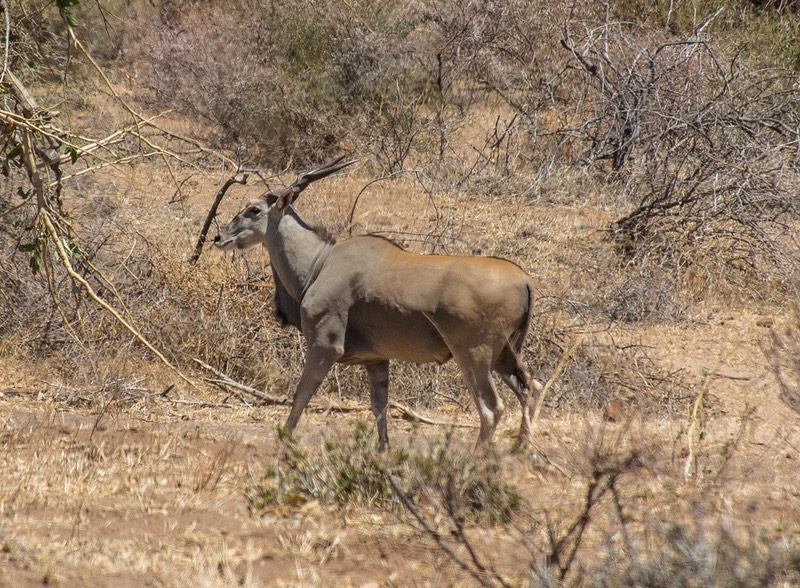
Locals who had been to the park before kept commenting on how dry everything was — to us, it was pretty normal for everything we’d been seeing this year. Not much rain in these here parts; and in this heat it was only going to get worse. Rainy season should be approaching, but people have their fingers crossed for more moisture than last year.
While in the park we did a pretty full day’s drive around a big loop looking for game and we saw plenty. Lots of elephants and giraffe, all the usual impala, wildebeest and waterbuck; but also our first klipspringers, which are small antelope (the name means rock jumper) and steenbok, which look like miniature impala — and our first oryx since Namibia. We even saw an eland, and we haven’t seen many of them.
A real treat for us on the day’s drive was encountering a group of youngsters in the midst of their lunch — near where we’d parked up to go for a bit of a hike. The mob was dressed in yellow t-shirts, and they were a real hoot.
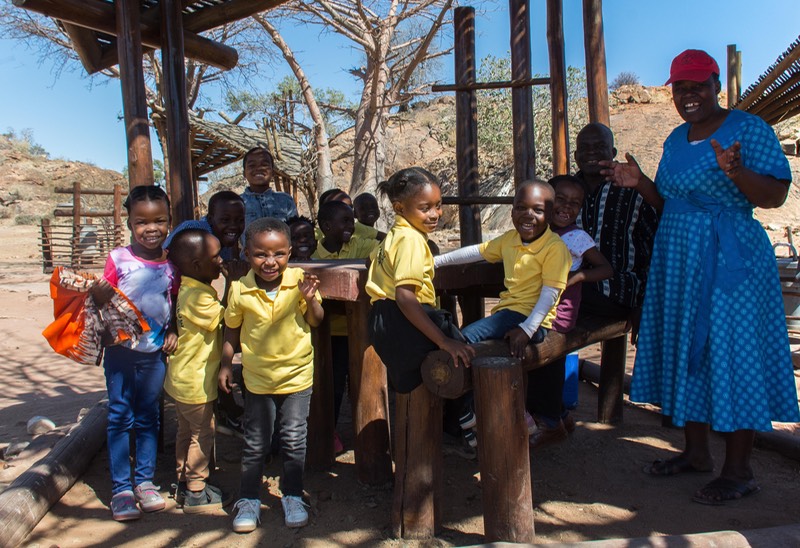
They waved and grinned and chanted hello in unison — then quickly scarfed down their food while we chatted a bit with their “minders.” Beautiful children, each and every one.
One of the attractions of Mapungubwe (other than mastering how to spell it — it means “Place of the Jackal” by the way) is that there is a viewpoint showing where three different countries come together: Zimbabwe, Botswana, and South Africa. This involves two rivers — the Limpopo and the Shashe — but in this very dry time of the year, there wasn’t much water in either, so it was maybe less impressive than at other times. But yeah, it was a good visit.
Mapungubwe is not all that far from the northern end of Kruger National Park, our next destination. We wanted to return to Kruger because it seemed to us to be one of the best overall animal experiences a person could have in southern Africa. We’d seen it so very early in our time here, and were, of course, in something of a hurry to keep moving and get on with it all. We now wanted a chance to take a more leisurely trip through the northern half of the park, which had been our favorite area before, revisiting some of our favorite spots, as well as finding and spending some time at places we’d not seen before.
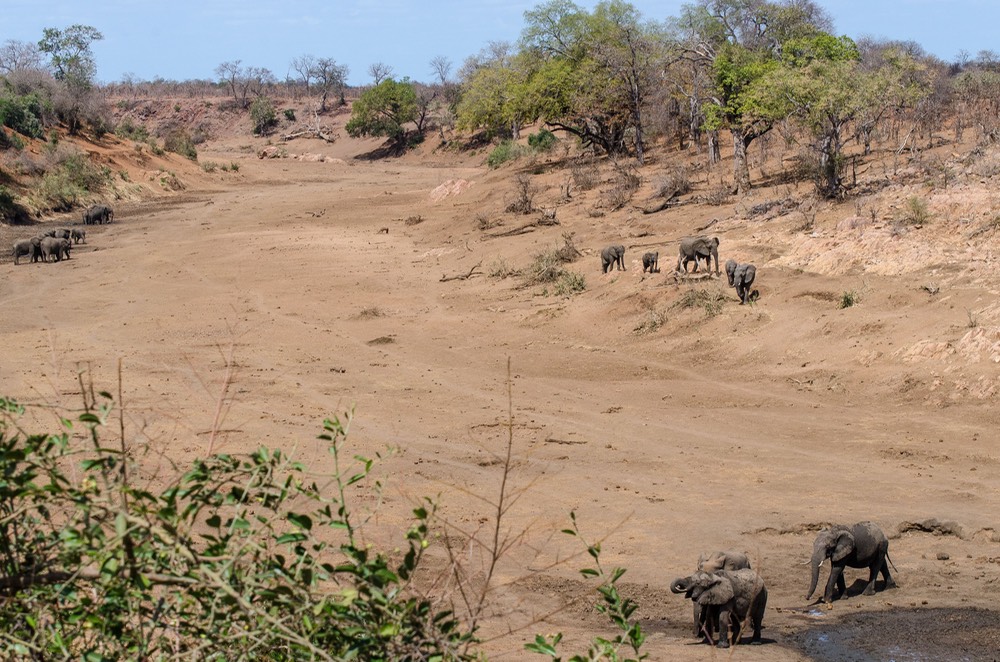
It was a good plan, and generally it worked out quite well. To give the negative on our time there, it just plain got hotter and hotter. It was well over 100℉ (38c) every day; manageable if you are parked under a tree sitting and enjoying a quiet day and plenty of iced tea, but not so good if you are out in the hot sun, traveling in a tin can and heating up the interior all day long. But ‘nuff said. We really enjoyed ourselves, but ended up being a bit constrained by the high temps.
Having been here thirteen months before, we could also now confirm for ourselves that things were a lot drier than they were last year. We revisited a number of hides and overlooks we’d seen before and could readily see the absence of water in the rivers and waterholes. This has been a very dry year in much of southern Africa, as we’ve mentioned before. In many areas the rainy season (roughly December to April) was non-existent and then the more mild winter rains (June to August) mostly failed to materialize as well. Unfortunately it really shows.
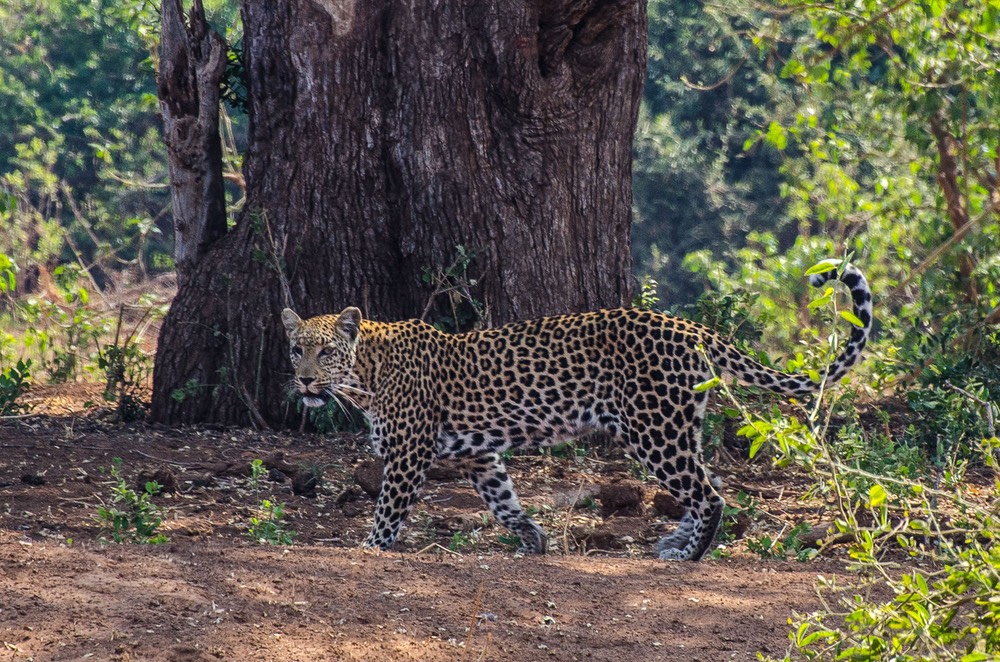
Even though we’re both from the mild California coast, we still managed in the heat, and had plenty of good experiences. We found ourselves willing to sit and watch the passing critters, enjoying their interactions and working on taking pictures that were a bit different than our usual. Typically, when photographing wild animals, you want to get as close as possible; have a clear view and get all of the animal in each shot. Stuff like that. But we found it fun to find our “subject” peering out from behind a tree, or mostly buried in a thicket, or just partly emerging from behind a rock. So that gave us new ways of looking at the wildlife. We enjoyed it.
Among the high points were certainly the beautiful leopard we saw walking along near the road; that happened early on our first morning in the park. And a few days later we got to see another one asleep in a big tree not too far away. Cool!
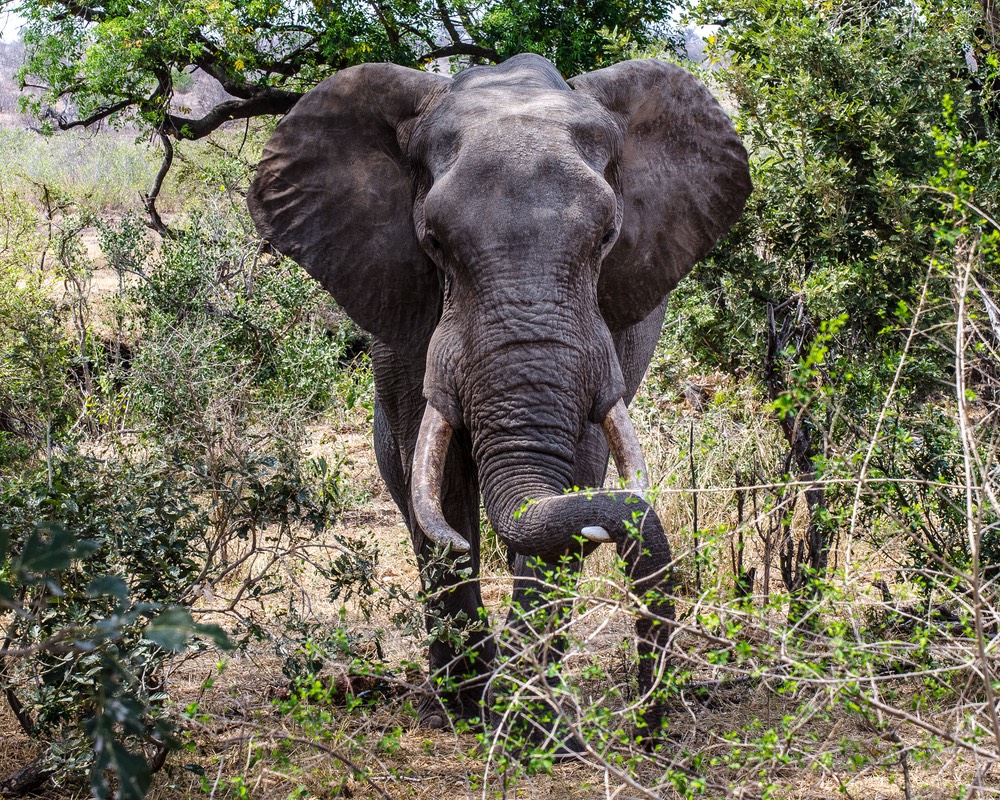
We saw elephants in large numbers, virtually a daily sighting. Some seemed distressed to us, having seen so many over the past fifteen months. We assume it was a combination of the lack of water and just the heat that was making everyone grumpy. At any rate, we observed more aggressive behavior among the elephants — with each other and with other animals as well as with us as we saw them along the road. At one water hole we saw a mother elephant with baby nearby actually chasing away a stork. At other times we saw the elephants flapping their ears and mock charging each other. We know these behaviors occur normally, but at this point in time we felt strongly that there was more anxiety among and within the herds than we’d seen before.
The real convincer though was when we came upon a large group just as they came out of the brush and approached the road. They were well clear of us so we stopped of course, under the shade of what turned out to be the largest tree in the area. We shut off the engine and settled in to watch what we assumed would be the group crossing the road and then wandering along on the other side. Not this time. Instead they immediately took very clear notice of us and took up a menacing posture, with several of them facing us directly with ears outspread. We weren’t all that close, but clearly they didn’t want us there. Bear in mind that we’ve been doing these game drives in the Tiger for many months and we’d been considerably closer to elephants many times before without this kind of reaction.
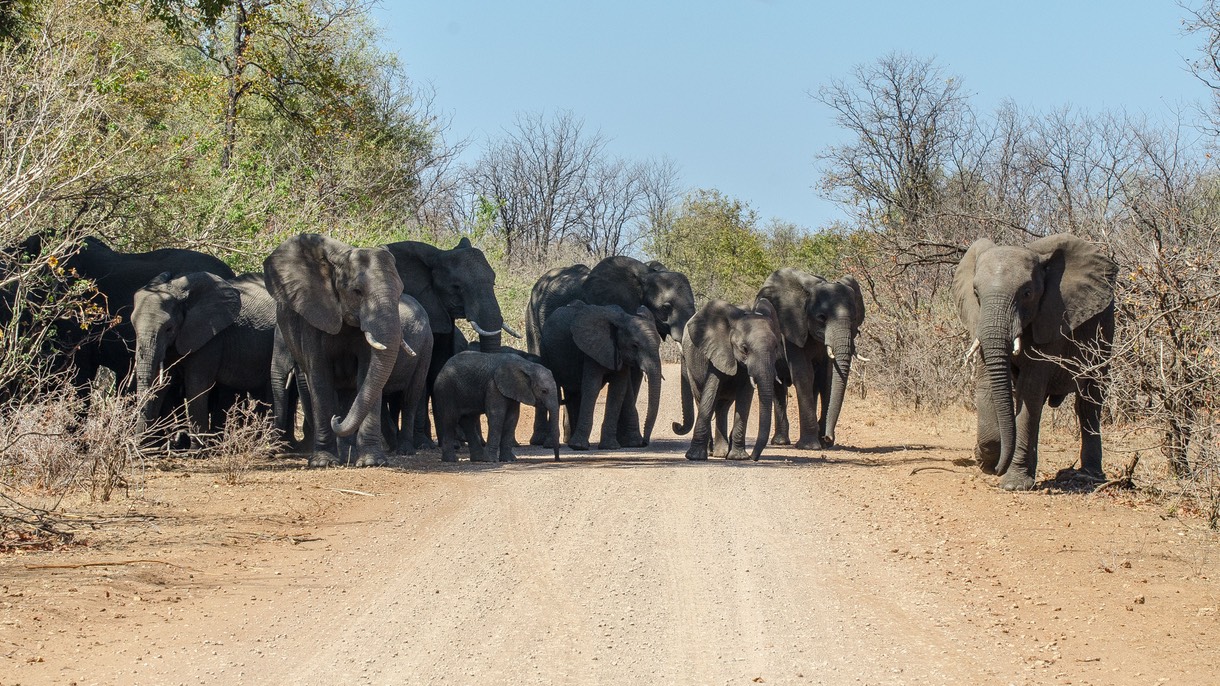
So, we dutifully backed up some more, and then even further, and watched as the herd moved right into the lovely shady spot we’d been enjoying. Once there they stood as a group in a defensive perimeter, partly blocking the road so we couldn’t go past. Well, after a while another vehicle came along with a nice father and three daughters. They stopped alongside us; we chatted about the elephants and why we were just sitting there. After a bit they began to slowly edge their car forward, but when they were about half way from us to the herd the elephants became agitated, stomping their feet and waggling their ears. Needless to say the father backed up and consulted with us about any way to get around to continue their drive.
We could see on our GPS that if we backtracked a few kms we should be able to make a connection with a smaller road that would loop around and bring us back to the road we were on, but on the other side of the herd. So they went on back, and we turned around to do the same. We did get around the herd and were able to continue, but it was quite an experience. In the end it seemed that those elephants just really wanted that shade.
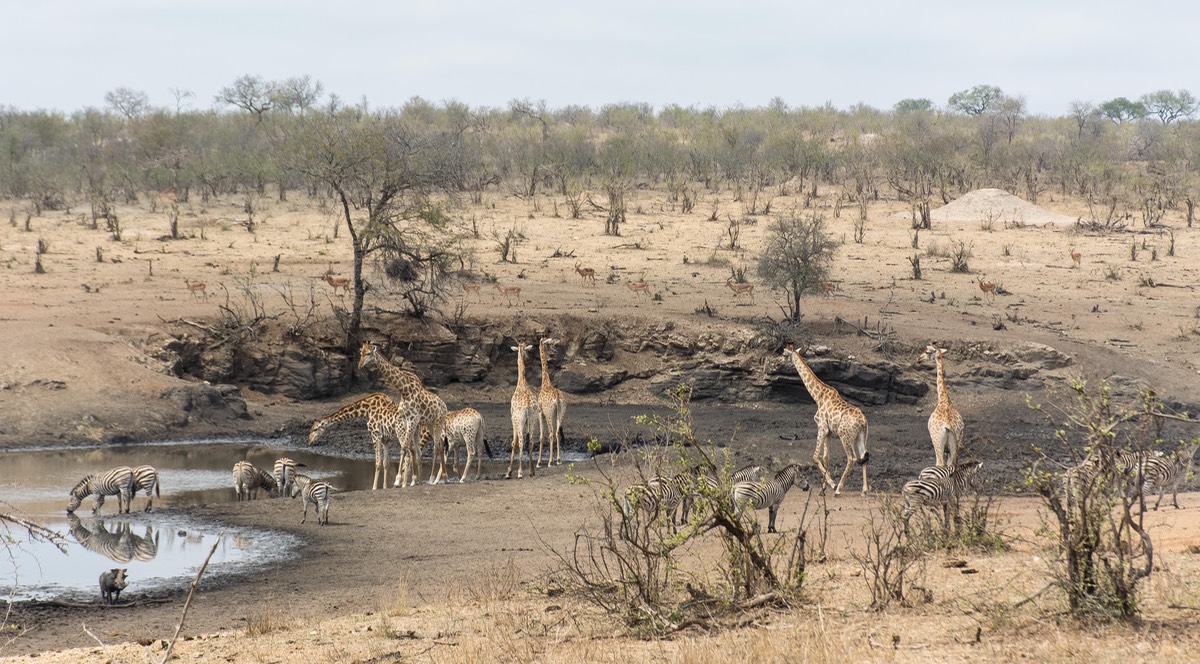
We continued to see animals, but not much water, to the point where we were feeling rather sorry for all the animals in the dry heat. Maybe it was because we were uncomfortably hot ourselves, but it seemed to us that many of them were just standing around, and not all had found shade. We also saw elephants in the dry river beds pawing at the ground and digging for water. We know this is quite common, and that the elephants are pretty successful at it but it was certainly a sign of the times.
Most of the game drives follow the rivers quite naturally, but things were pretty darn dry in most places. We saw a few pools with enough water for small groups of hippos and crocodiles to be found, but not many. As the dryness is so widespread, we really don’t know where the rest of the hippos and crocs have gone.
We hope we haven’t made too much of a big deal out of the heat and lack of water — we know it’s pretty normal at this time of year. The overall result for us, however, was that we cut short our game drive schedule and spent more time in camp than we normally would. You couldn’t get up early enough to beat the hot sun.
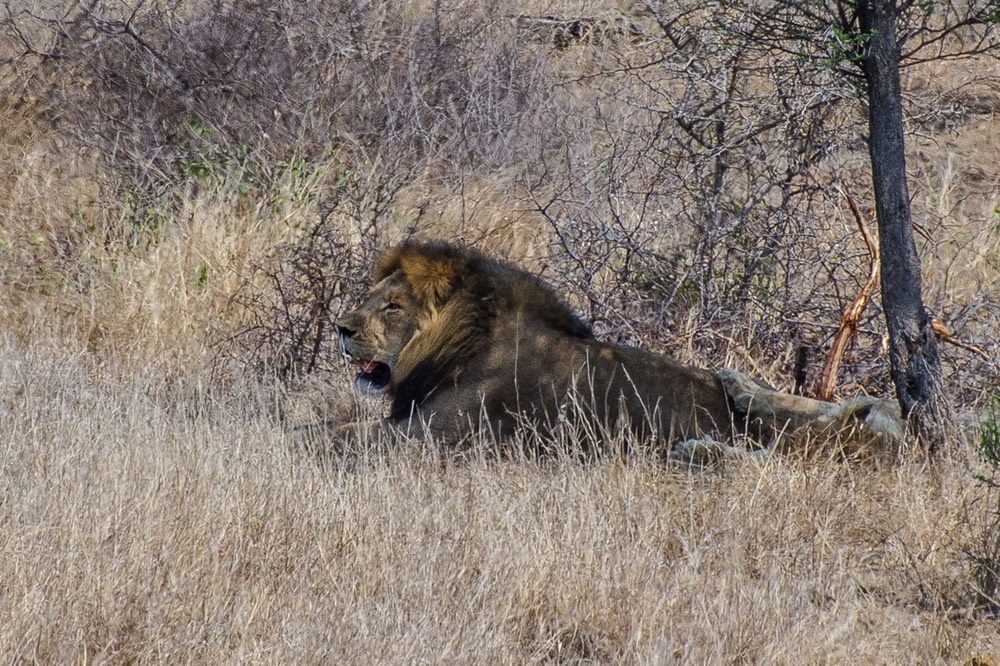
Now, we really don’t want to sound negative about our trip to Kruger because we did have some great sightings and saw large numbers of animals. The two leopards, which we’ve already mentioned, justified the trip on their own. They are just so beautiful, and in both cases we were close enough to really enjoy them. We also spotted a lion yawning in a shady grassy spot beneath a tree. He was in the company of a fine lioness who had her paws draped all over his back; that was all we could see of her, so we could only surmise she was dreaming of her next kill.
Later on, we almost ran over a group of hyenas in your basic lump beside the road. They’d obviously just eaten very well and were sleeping off their gorging. When we didn’t immediately move on, slowly-slowly one-by-one they managed to stand up and move a few feet back into the brush. Sleeping was apparently much more important than making ferocious noises to scare us off!
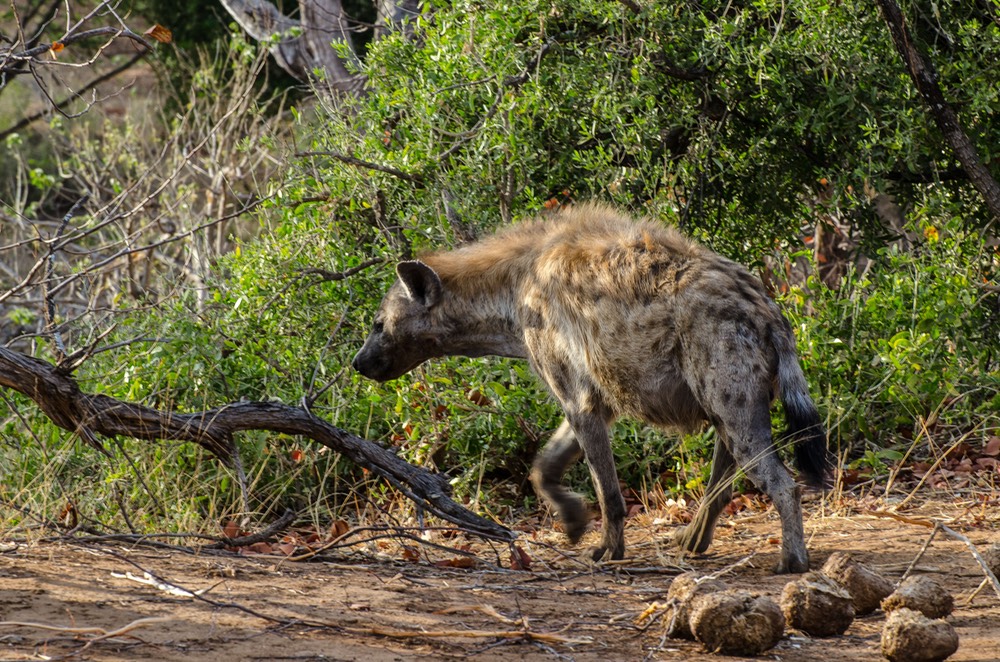
These sightings were in addition to copious numbers of different varieties of antelope large and small so aside from the heat, it was a great visit to a great park. On a game drive, most folks are always hoping to see the cats; in Kruger that means lions and leopards. So as you drive along you are scanning the left and right sides of the road looking for movement. If we’ve learned one thing on these drives, it is that if the impala and other antelope around are calmly munching, it basically constitutes a sign saying, “No Lions Here”, so we wouldn’t strain too much looking for them.
And we also saw a whole bunch of what has easily become one of our favorite African animals, the giraffe. They seemed to be doing better than some others and since they are the only ones who can reach the tree leaves that make up most of their diet, they seemed to have plenty to eat. At one point, though, we imagined a conversation between a couple of them as they stood in the shade eating leaves: “Hey, Ralph, quit eating all the shade.” Please forgive our weak humor, but we laughed about it at the time. We find the giraffe endlessly interesting and fun to watch. They are just the definition of imperturbable: calm, relaxed, graceful in their movements, pretty and quirky-looking all at the same time. What’s not to love.
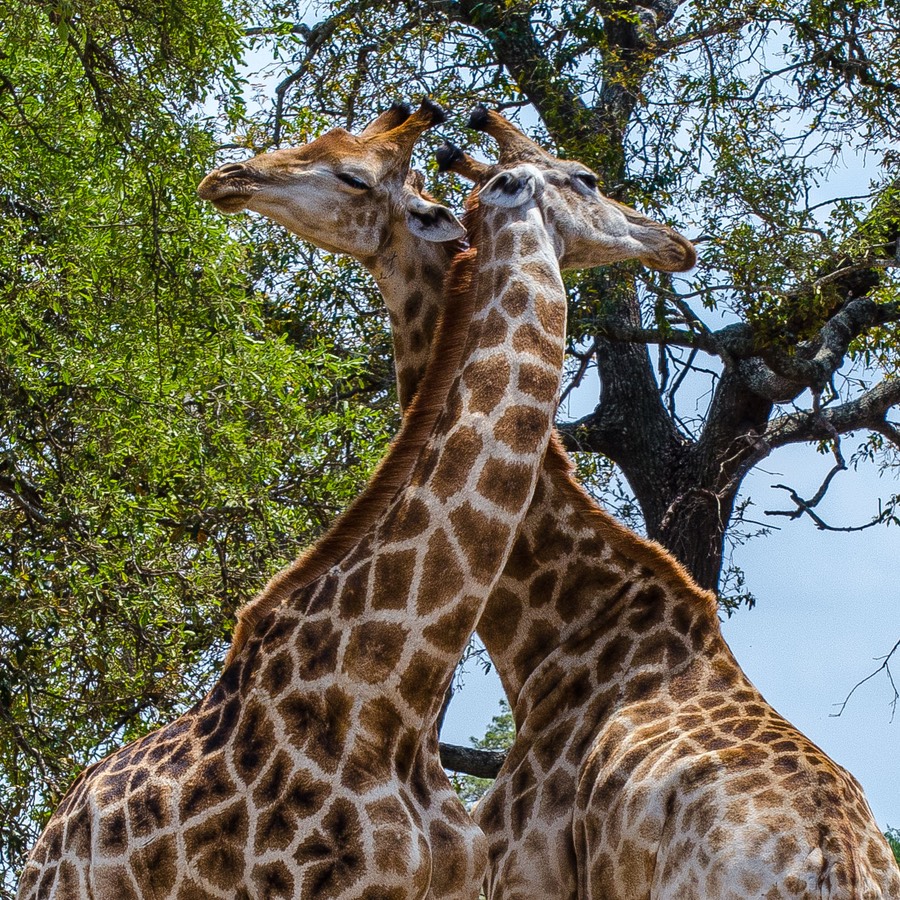
In addition to lots and lots of just regular good-looking giraffe, we came across a pair who seemed to be dancing; swinging their heads and intertwining their necks. At first, we thought it must be a mating dance as it looked quite graceful and even affectionate. On further study, however, we could see they were both males; and in asking about this later we learned that this behavior was mock fighting, in the same way we’ve seen antelope butting heads for example. The giraffe’s neck is extraordinarily strong and apparently the little furry antlers on top of their heads can actually do quite a lot of damage. Anyway, we sat fascinated and enjoyed the spectacle. You will want to see the twenty photos of the dancing giraffes on our Kruger NP photo page.
A short while later we stopped to watch a fine specimen of a white rhino — the only one we saw in Kruger this year. And then a zillion elephants at the nearby dam. In the next couple of days we stopped to enjoy the southernmost baobab in Africa — a gigantic one. And more and more elephants, giraffe, water buffalo and, and, and… It never stops. At Kruger you’re never bored! There’s always something around the next corner.
We spent our last night in the park at Skukuza, a huge and cluttered campground that is the park headquarters. Here, or maybe it was at an earlier campsite, we treated ourselves to a meal in the restaurant. Pretty darn good, I might add. The following morning, as we headed towards the nearby park exit, we took the time to stop at one of the best bird hides in Kruger, the Lake Panic Hide, just a few kms from Skukuza. We had decided to exit the park at this gate because we’d had such an excellent experience when we’d been here a year ago.
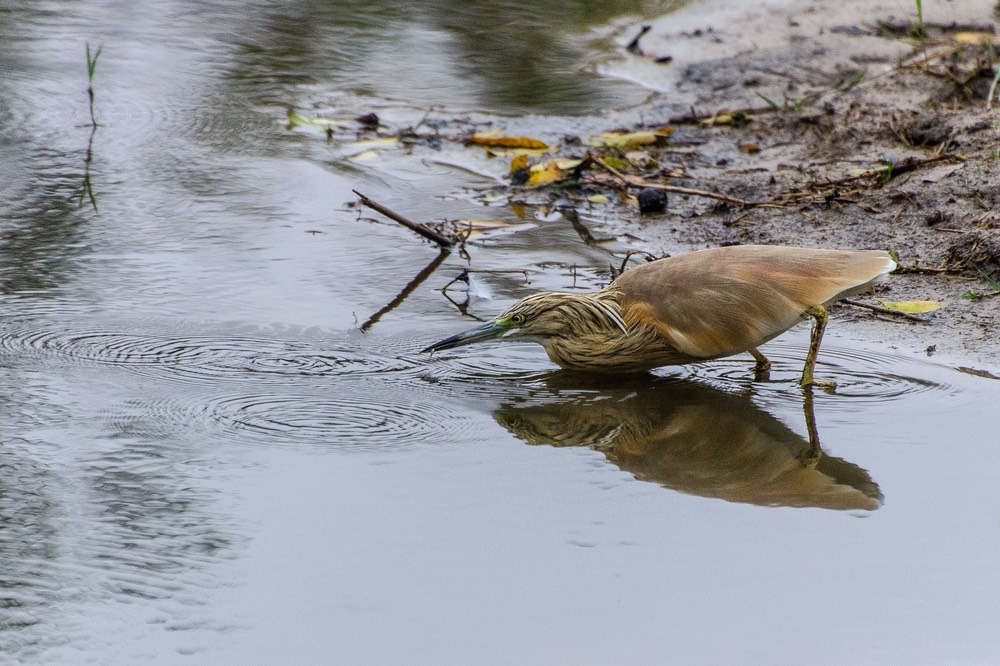
It was just as nice this time around. There was plenty of water to attract the birds, and they were plentiful. The hide is beautifully positioned for the morning sun, great for picture-taking, and made a terrific end to our time in Kruger. Finally tearing ourselves away, we headed west from the park, aiming for Nelspruit (aka Mbombela), a great place to catch your breath, get the dust out of your lungs, shop and do some laundry.
We also have some issues to address. Kathy needs to see a dentist and Rick is quite firm about not only looking into the issue of the grouchy water pump, but also investigating the more recent sudden demise of our water heater as well. Team Tortuga is beginning to limp toward the finish line just a bit. Oh, and as we drove along after leaving Kruger it even started to rain a little and we quickly discovered that we need new wiper blades; not surprising as we've seen hardly any rain in months. Good thing Mbombela has lots of places that carry such things.
We’ll be back on the road shortly, off to visit the Indian Ocean. Our visas don’t expire until December 12, and we’ve got lots left to see. Gotta get busy!
So long for now, from Rick, Kathy, and the Tiger (now sometimes known as The Dry Tortuga)
Don’t miss the Photo Page for this story, and also
the separate page for all the pictures from Kruger National Park